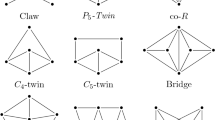Abstract
We present an O(n5) combinatorial algorithm for the minimum weighted coloring problem on claw-free perfect graphs, which was posed by Hsu and Nemhauser in 1984. Our algorithm heavily relies on the structural descriptions of claw-free perfect graphs given by Chavátal and Sbihi and by Maffray and Reed.
Similar content being viewed by others
References
C. Berge and V. Chvátal (Eds.), Topics on Perfect Graphs. North-Holland, Amsterdam, 1984.
M. Chudnovsky, N. Robertson, P.D. Seymour, and R. Thomas, “The strong perfect graph theorem,” Ann. of Math., to appear.
V. Chvátal, Linear Programming. W.H. Freeman and Company: New York, 1983.
V. Chvátal and N. Sbihi, Bull-free Berge graphs are perfect. Graphs Combin, vol. 3, pp. 127–139, 1987.
V. Chvátal and N. Sbihi, “Recognizing claw-free perfect graphs,” J. Combin. Theory Ser. B, vol. 44, pp. 154–176, 1988.
D.G. Degiorgi and K. Simon, “A dynamic algorithm for line graph recognition,” Lecture Notes in Comput. Sci., vol. 1017, pp. 37–48, 1995.
L.R. Ford, Jr. and D.R. Fulkerson, “Maximal flow through a network,” Canad. J. Math., vol. 8, pp. 399–404, 1956.
M.R. Garey and D.S. Johnson, Computers and Intractability. W.H. Freeman and Company, New York, 1979.
F. Gavril, “Algorithms on clique separable graphs,” Discrete Math., vol. 55, pp. 245–254, 1985.
T. Gonzalez and S. Sahni, “Open shop scheduling to minimize finish time,” J. Assoc. Comput. Mach., vol. 23, pp. 665–679, 1976.
M. Grötschel, L. Lovász, and A. Schrijver, “Polynomial algorithms for perfect graphs,” in Topics on Perfect Graphs C. Berge and V. Chvátal (Eds.) North-Holland, Amsterdam, 1984, pp. 325–356
J.E. Hopcroft and R.M. Karp, “An n5/2 algorithm for maximum matchings in bipartite graphs,” SIAM J. Comput., vol. 2, pp. 225–231, 1973.
W.L. Hsu, “How to color claw-free perfect graphs,” Ann. Discrete Math., vol. 11, pp. 189–197, 1981.
W.L. Hsu and G. Nemhauser, “Algorithms for maximum weight cliques, minimum weighted clique covers and minimum colorings of claw-free perfect graphs,” in Topics on Perfect Graphs C. Berge and V. Chvátal (Eds.) North-Holland, Amsterdam, 1984, pp. 357–369.
W.L. Hsu and G. Nemhauser, “Algorithms for minimum covering by cliques and maximum clique in claw-free perfect graphs,” Discrete Math., vol. 37, pp. 181–191, 1981.
W.L. Hsu and G. Nemhauser, “A polynomial algorithm for the minimum weighted clique cover problem on claw-free perfect graphs,” Discrete Math., vol. 38, pp. 65–71, 1982.
A.V. Karzanov, “Determining the maximal flow in a network by the method of preflows,” Soviet Math. Dokl., vol. 15, pp. 434–437, 1974.
P.G.H. Lehot, “An optimal algorithm to detect a line graph and output its root graph,” J. Assoc. Comput. Mach., vol. 21, pp. 569–575, 1974.
L. Lovász, Normal hypergraphs and the perfect graph conjecture,” Discrete Math., vol. 2, pp. 253–267, 1972.
F. Maffray and B. Reed, A description of claw-free perfect graphs,” J. Combin. Theory Ser. B, vol. 75, pp. 134–156, 1999.
K.R. Parthasarathy and G. Ravindra, “The strong perfect graph conjecture is true for K1,3-free graphs,” J. Combin. Theory Ser. B, vol. 21, pp. 212–223, 1976.
J.L. Ramfrez-Alfonsín and B.A. Reed (Eds.), Perfect Graphs. John Wiley & Sons, Ltd., Chichester, 2001.
N.D. Roussopoulos, “A m, n algorithm for determining the graph H from its line graph G,” Inform. Process. Lett., vol. 2, pp. 108–112, 1973.
A. Schrijver, Theory of Linear and Integer Programming. John Wiley & Sons, 1986.
R.E. Tarjan, “Decomposition by clique separators,” Discrete Math., vol. 55, pp. 221–232, 1985.
R.E. Tarjan, Data Structures and Network Algorithms, SIAM, Philadelphia, 1983.
S.H. Whitesides, “An algorithm for finding clique cut-sets,” Inform. Process. Lett., vol. 12, pp. 31–32, 1981.
Author information
Authors and Affiliations
Corresponding author
Additional information
Supported by the National Science Foundation of China.
Supported by the Research Grants Council of Hong Kong (Project No. HKU 7109/01P) and Seed Funding for Basic Research of HKU.
Rights and permissions
About this article
Cite this article
Li, X., Zang, W. A Combinatorial Algorithm for Minimum Weighted Colorings of Claw-Free Perfect Graphs. J Comb Optim 9, 331–347 (2005). https://doi.org/10.1007/s10878-005-1775-y
Received:
Revised:
Accepted:
Issue Date:
DOI: https://doi.org/10.1007/s10878-005-1775-y




